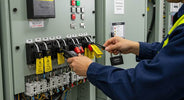
Electrical Lockout Device Setup for Safe Isolation
, by jonas heldmark, 13 min reading time

, by jonas heldmark, 13 min reading time
Safe isolation isn't just a checklist item—it's a vital protection strategy that can save lives. As industries grow more complex and automated, ensuring proper electrical lockout procedures becomes essential. It prevents unexpected energization of electrical circuits during maintenance and repair.
Whether you're managing a manufacturing plant or a remote energy site, having compliant tools like those from Archford can make all the difference. Their extensive collection of lockout tagout kit products is designed to meet Australian standards and simplify electrical safety practices.
An electrical lockout is the process of physically securing energy isolation points (such as breakers and switches) to prevent them from being turned back on. It's a crucial component of the Lockout/Tagout (LOTO) system.
Without a proper lockout device, workers are exposed to the danger of electric shock, arc flash, or mechanical movement—any of which can be fatal.
A lockout device ensures that power remains disconnected and no one can accidentally reactivate the system. These devices come in various forms:
Using a LOTO tool suited to your equipment helps maintain safety while making implementation fast and foolproof.
Here’s how to perform a lockout setup:
You might wonder: How to set up electrical lockout? It starts with training, the right equipment, and clearly defined procedures. Your team must know:
You should also include lockout planning into preventive maintenance schedules for high-risk systems like conveyors, pumps, and electrical cabinets.
Not all devices are made equal. Choosing the right LOTO tool can save both time and lives.
Archford provides durable and versatile options for various industries. For example, their lockout tagout kit includes:
Every kit is built to withstand the rigors of industrial environments, ensuring long-term reliability.
Power isolation is the central concept behind electrical lockout. It refers to physically disconnecting a device from its energy source—whether electricity, gas, or hydraulic pressure.
Without power isolation, other lockout actions become ineffective. That’s why Australian regulations prioritize ensuring all systems are tested, locked, and tagged before work begins.
Implementing safe electrical lockout methods involves:
Archford supports companies in fulfilling these duties by offering robust tools, signage, and best-practice resources.
Avoid:
Proper lockout setup reduces liability and improves worker trust.
Archford specializes in supplying workplace safety equipment across Australia. Their curated lockout tagout kit offerings make it easier for you to stay compliant and organized.
Also, check out their blog on Safety Labels—a valuable companion to your LOTO program that ensures visibility and accountability.
Archford empowers teams by providing not just equipment, but also guidance on how to use it effectively.
Routine maintenance of lockout equipment is crucial. Keep these tips in mind:
Well-maintained tools ensure reliable performance during critical operations.
|
Tips / Guide Summary |
|
|
Select kits with multi-lock hasps, padlocks, and tags suitable for your industry. |
|
|
Use non-conductive or keyed-alike locks for easier and safer LOTO application. |
|
|
De-energize sources and use circuit breaker or plug lockout devices per procedure. |
|
|
Use proper devices for ball, gate, or butterfly valves; attach lock + tag always. |
|
|
Apply colored floor tape for equipment zones, hazard areas, and safe walking paths. |
|
|
Install on stairs, ladders, and wet areas to prevent slips, especially outdoors. |
|
|
Include hard hats, gloves, eye protection, respirators, and safety footwear in kits. |
|
|
Provide annual training and refreshers using real-world scenarios and documented tests. |
|
|
Include procedures, device inspections, employee responsibilities, and recordkeeping. |
|
|
Ideal for securing multiple valves or electrical panels with one locking point. |
LOTO is not just a regulation—it’s a culture of protection. Every time a worker applies a padlock, they're making a commitment to safety.
By maintaining compliance and investing in the right tools and training, companies reinforce their commitment to their team’s wellbeing. Organizations partnered with suppliers like Archford are positioned to lead the way in electrical safety—turning policy into practice.
A: Not verifying zero voltage before starting work. Always test after isolating.
A: Yes, as long as it’s not damaged and remains functional.
A: Look at manufacturer specs or consult Archford’s customer support team.
A: Yes, under AS/NZS 4836 and WHS Regulations.
A: Only trained and authorized personnel can install and remove lockout devices.